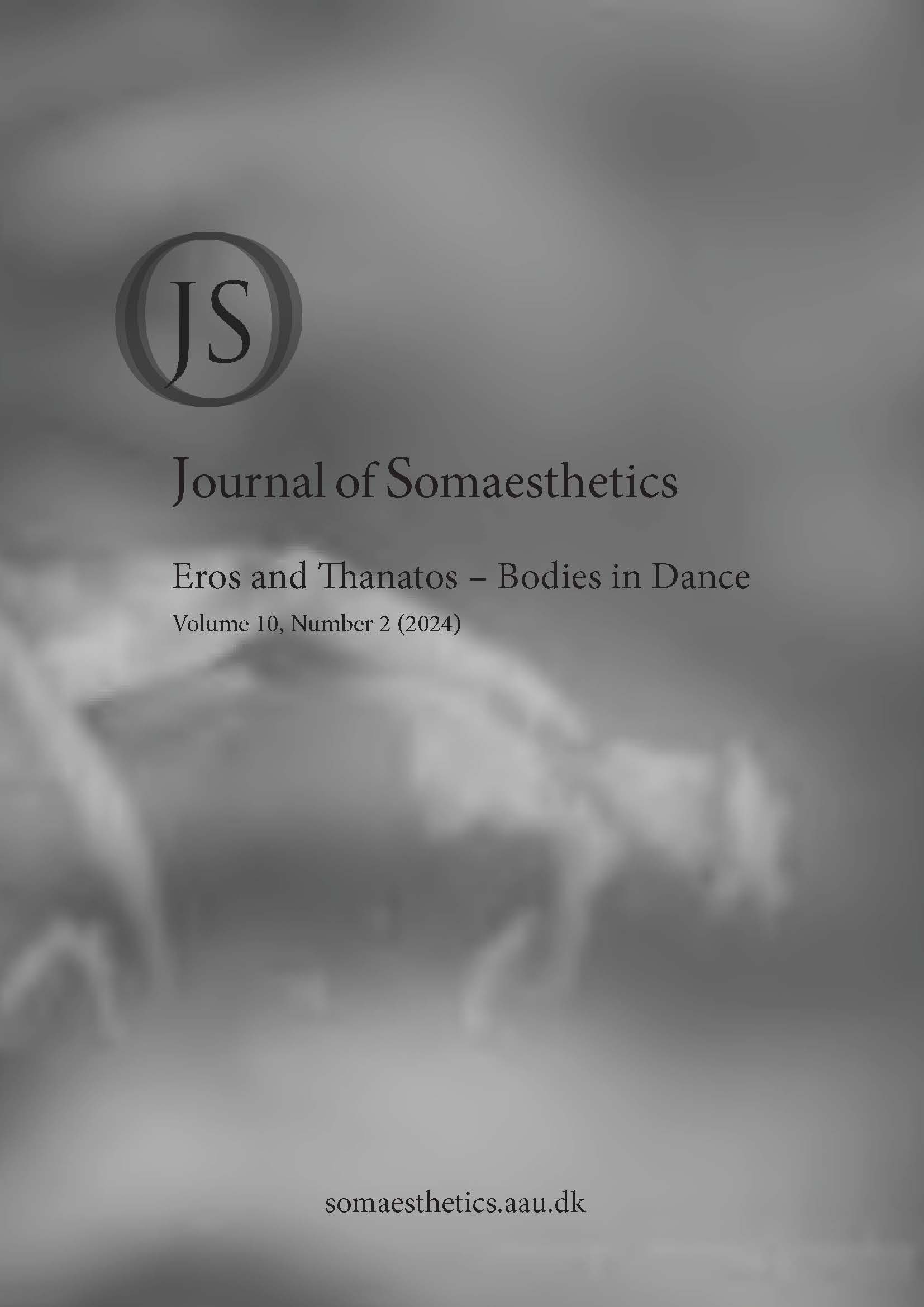Somatic Composition and Embodied Filmmaking
case study on practice and practitioners through the example of a Creative Lab
DOI:
https://doi.org/10.54337/ojs.jos.v10i2.8600Abstract
How do we film from the body, and how do we embody (moving)images? How do we make film, when we invite a somatic approach into filmmaking? What do we film, when we film with and from not only our exteroception but invite as well our interoception into the process? What do we film, when we film bodies in motion or in stillness? How can we transmit the quality of space around and within the body?
Among others, these questions were the starting points for the Creative Lab[1] in Tallinn, entitled Somatic Composition and Embodied Film, which I facilitated in March 2024, in partnership with Somaatikum, center for Body Mind Centering® education in Estonia, SZOME Association for Somatic Education and Movement in Hungary, and TantsuRUUM (Estonia). The workshop and lab aimed to directly apply somatic practice – in this case Body-Mind Centering®, or BMC® – to the creative process, to inform and generate both the movement (dance) practice and the filmmaking practice. Within this one week, we dived into our somatic self, into our living bodies, while also studying contemporary and embodied film theories and examples. From these sources participants started their creative work. It's important to note, that the frame of the lab was a low-tech approach of filmmaking in a limited time. The outcomes of the lab may therefore be experimental short films - complete as they are -, or drafts for a future film.
The case study examines the dance- and somatic practice that lays behind these works, the working method and the way of participation and facilitation in dialogue with each other. It includes reflection on the process and on the moving image works that were created along this process. It includes reflections not only by the author of this article, and facilitator of the Lab, but also by the participants.
References
Bainbridge Cohen, B. (2018) Basic Neurocellular Patterns: Exploring Developmental Movements. El Sobrante, CA, USA: Burchfield Rose Publishers
Bainbridge Cohen, B. (2012) Sensing, Feeling and Action: The Experiential Anatomy of Body-Mind Centering® (3rd edition). Northampton MA, USA: Contact Editions
Bainbridge Cohen, B. (1991) The Dynamics of Flow: The Fluid System of the Body. Sensing, Feeling and Action (2012), Originally published in Contact Quarterly CQ 16:2 Spring/Summer 1991.
Cranny-Francis, A. (2009) Touching Film: The Embodied Practice and Politics of Film Viewing and Filmmaking. The Senses and Society 4(2):163-178
Gelencsér, G. (2001) A Budapesti Iskola: Fikciós dokumentumfilmek a hetvenes évek magyar filmművészetében. Iskolakultúra 2001/10, page 59 - 72. Retrieved from https://www.iskolakultura.hu/index.php/iskolakultura/article/view/19536/19326
Kuhlmann, H. (2023) The Development of Movement and the Self. The fluid nature of being, ed. Linda Hartley (p. 111). London: Singing Dragon. Retrieved from https://www.researchgate.net/publication/368659872_The_Development_of_Movement_and_the_Self
Hockley, L. (2014) Somatic Cinema. Abingdon, Oxon, UK: Routledge
Lorenz, K. (1987) The Waning of Humanness (KICKERT, Robert Warren Trans.). Canada, Little, Brown and Company. (Original work published in 1983 by R. Piper & Co. Verlag, Munich)
Lukács, L. (2020) Hogyan szeretsz? Kötődési sebeink gyógyítása. Budapest, HU: Kulcslyuk Kiadó
Morris, R. (1995) The Present Tense of Space – in Continuous Project Altered Daily: The Writings of Robert Morris. Cambridge, MA: The MIT Press
Murch, W. (2001) In the Blink of an Eye. A Perspective on Film Editing. (2nd edition). West Hollywood, CA, USA: Silman-James Press. (Original work published in 1992)
PAE 30 – The Promise of Pragmatist Aesthetics: Looking forward after 30 years, conference booklet; MOME Doctoral School and Magyar Szómaesztétikai Fórum (Hungarian Somaesthetics Forum), 2022
Roundtable discussion in the frame of Somatic Composition and Embodied Filmmaking Lab, Tallinn [2024]; documentation: https://onopordum.hu/en/portfolio-item/somatic-composition-and-embodied-filmmaking-lab-tallinn-2024-en/
Roundtable discussion in the frame of MKE_KDP_roundtable discussion #2, Budapest (2024); documentation: https://onopordum.hu/en/portfolio-item/mke_kdp_kerekasztal-2-en-2/
Szűcs, R. (2016) On Choreographic Moving Images: Analytical experiments. University of Theatre and Film, Doctoral School
The School for Body-Mind Centering® (1992) Qualities of the Fluids – in study materials for the Fluid System course
Downloads
Published
Issue
Section
License
Copyright (c) 2024 Bernadett Jobbágy

This work is licensed under a Creative Commons Attribution-NonCommercial-NoDerivatives 4.0 International License.
Articles published in The Journal of Somaesthetics are following the license Creative Commons Attribution-NonCommercial-NoDerivs 4.0 Unported (CC BY-NC-ND 4.0). Authors retain copyright and grant the journal right of first publication with the work simultaneously licensed under a Creative Commons Attribution License: Attribution - NonCommercial - NoDerivs (by-nc-nd). Further information about Creative Commons
If excerpts, tables, figures, charts, artwork or photographs from other copyrighted works are included in an article, it is the author’s responsibility to obtain written permission from the copyright owners and credit the source’s in the article and citation list.


